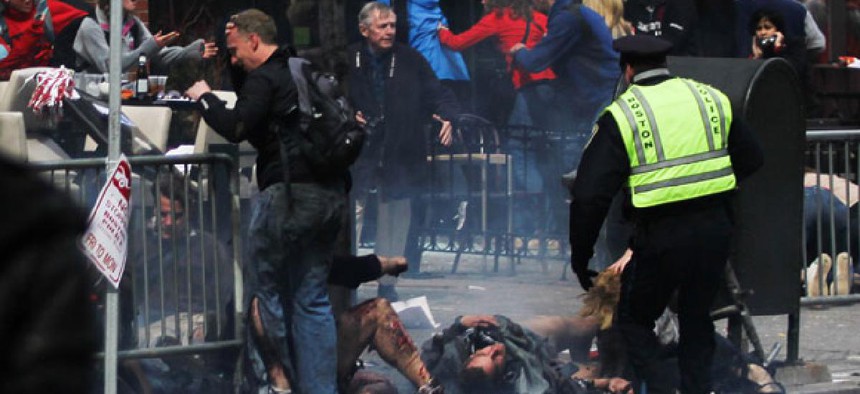
Kenshin Okubo/AP
How the Government Searches for the Boston Marathon Bomber
The FBI may have been most transformed by post-9/11 reforms.
When FBI special agent Richard DesLauriers promised that “We will go to the ends of the Earth” to find the terrorists responsible for the bombing of the Boston Marathon and bring them to justice, he was not making an idle threat. The post-9/11 record strongly suggests that the U.S. authorities will indeed get their man.
Inevitably, the tragic terrorist attack in Boston, coupled with reports that poison-laced letters have been sent to Congress and the White House, have recalled disturbing memories of 9/11. However, Wednesday’s news that authorities believe they already have video of the likely bomber, along with detailed forensic analysis of the type of bombs used, are reminders that law enforcement and intelligence officials have counterterrorism capabilities at their disposal today that would have been unthinkable before Sept. 11, 2001.
Even as DesLauriers spoke, for instance, a globe-spanning network of Joint Terrorism Task Forces and intelligence fusion centers, and the tens of thousands of analysts and operators who run them, were already scouring all-source intelligence for a telltale clue or whiff of digital exhaust. Intercepted telephone calls and e-mail exchanges, surveillance camera footage, airline manifests, hotel registries, car-rental records, tips from informants and the public—all of it was being fed into powerful computers and matched against a database of half-a-million suspected terrorists maintained by the National Counterterrorism Center in Northern Virginia. All it will take for the entire network to narrow its focus into a “hard stare” is for two seemingly disparate data points to align, allowing analysts to connect the dots.
“After the 9/11 attacks, the U.S. government took the recommendations of the 9/11 Commission very seriously, and it transformed the way terrorism cases are handled by giving law enforcement and intelligence agencies more resources, more legal authorities, and a lot of cutting-edge technologies to reduce the chances of future attacks,” said Laura Dugan, a principal investigator for the National Consortium for the Study of Terrorism and Responses to Terrorism. “Collectively that has greatly enhanced our counterterrorism capabilities, but it should be no surprise that an attack like Boston still happened. Most terrorism experts will tell you that the real surprise is another terrorist attack didn’t occur sooner.”
Important post-9/11 reforms include the creation of the Department of Homeland Security to harden domestic targets and guard against attacks; establishment of the National Counterterrorism Center to act as a clearing house for collection and analysis of all-sources of intelligence; and passage of the Patriot Act, the FISA (Foreign Intelligence Surveillance Act) Amends Act, and other legislation greatly expanding the authorities of U.S. law enforcement and intelligence agencies to secretly monitor communications with suspected terrorists, and track terrorist financing. Many of the firewalls separating foreign and domestic intelligence-gathering, and military and civilian intelligence agencies, were also dismantled.
As the lead agency in domestic terrorism investigations, the FBI has arguably been most transformed by the post-9/11 reforms. The bureau has expanded beyond from its traditional role as a post-facto criminal investigative service, turning instead into a domestic-intelligence-gathering agency with a mission to preempt acts of terrorism before they occur. The result has been a wholesale change in the corporate culture of the FBI, with the bureau increasingly focused on infiltrating terrorist groups and preempting domestic terrorist plots in “stings” orchestrated by informants.
Though controversial, those tactics and the U.S. government’s post-9/11 record speak to the effectiveness of the reforms. Between 9/11 and the Boston terrorist attack, only 14 Americans were killed by jihadi terrorists on U.S. soil (13 were shot at Ft. Hood, Texas, in November 2009 by Army Major Nidal Hassan; and one Army recruiter was killed in front of a recruiting office in Little Rock, Ark., in a July 2009 drive-by shooting). According to a Rand Corporation study, between 2001 and 2012, 41 terrorist plots were launched by homegrown terrorists. Of those, 38 were uncovered and foiled by U.S. law enforcement agencies. Of the 14 most serious plots, 10 were disrupted by FBI “stings.”
“That’s really a remarkable record,” said Rand counterterrorism expert and author Brian Michael Jenkins. It reflects, he notes, the synergistic effect of improved intelligence-sharing, changes in surveillance law, a determination to disrupt terrorist plots before they hatch, and growing U.S. expertise in large-scale terrorism investigations stretching back to the first World Trade Center attack in 1993.
Barely a whiff of digital exhaust is all it takes to activate a global network of surveillance sensors, supercomputers, intelligence-fusion centers, and the analysts and operators who run it. One of half-a-million suspected terrorists in the U.S. database logs onto the grid somewhere—and the network’s trackers pick up the scent. The network’s power rests in its ability to rapidly synthesize enormous amounts of all-source intelligence and discern “patterns of life,” the better to anticipate a target’s next move and initiate a strike.
“So when President Obama and the FBI stand up and say, ‘We will bring these terrorists to justice,’ I have a high degree of confidence that they are actually right,” Jenkins said. “There will likely be more false leads, and it could take weeks, months, or even years rather than hours and days. But I believe they’ll ultimately identify and bring the Boston bomber or bombers to justice.”
NEXT STORY: 7 Reasons to Worry About North Korea's Weapons







